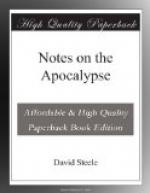If we are to interpret the “beasts of the earth” literally, then we may easily perceive how the depopulation produced by the other calamities would make way for their increase and destructive ravages. But if we understand these “beasts” as symbolizing the persecuting powers; then adding these to all the other destructive agencies,—especially to the “pale horse,” the chief symbol in the group; we may readily perceive the force of the combined emblems, a concentrating, as it were, of all destroying agencies. Historians inform us, that “a pestilence arising from Ethiopia, went through all the provinces of Rome, and wasted them for fifteen years.” This, added to the sword of war and persecution, which lasted sixty years, according to some interpreters, or from 211 to 270, would seem to exhaust the events symbolized by the series of the seals, except the seventh, so far at least as the sufferings of the church are concerned. For under the fifth and sixth seals, as will appear, nothing of a calamitous nature befalls the righteous.
9. And when he had opened the fifth seal, I saw under the altar the souls of them that were slain for the word of God, and for the testimony which they held:
10. And they cried with a loud voice, saying, How long, O Lord, holy and true, dost them not judge and avenge our blood on them that dwell on the earth?
11. And white robes were given unto every one of them; and it was said unto them, that they should rest yet for a little season, until their fellow-servants also, and their brethren, that should be killed as they were, should be fulfilled.
Vs. 9-11.—At the opening of the fifth seal, none of the “four animals” calls attention to its contents. This fact may indicate that no new development of providence is intended, but rather the effects of the preceding three, produced upon the church and saints of God; as the sixth discloses the penalty inflicted on his and their enemies.
John saw the “souls of them that were slain.”—Souls are visible only in vision, (ch. xx. 4.) These souls were not slain, but they were the souls of them, the persons, that were slain. (Matt. x. 28.) The enemy could kill the body only, an essential part of the human person, although the chief aim was to kill the soul. The ground of their suffering was the same, as that of John, (ch. i. 9.) And from the first of this honoured class,—Abel, mentioned in the Bible, to the last,—Antipas; the cause is the same, and the distinguished name is the same. They are “martyrs for the word of God, and for the testimony which they held.” And however tenaciously a person may hold other principles, even though he should die for them, he is not a martyr. The aphorism is true,—It is not suffering for religion, but “the cause that makes the martyr,”—suffering unto death from love to “the truth as it is in Jesus.”




